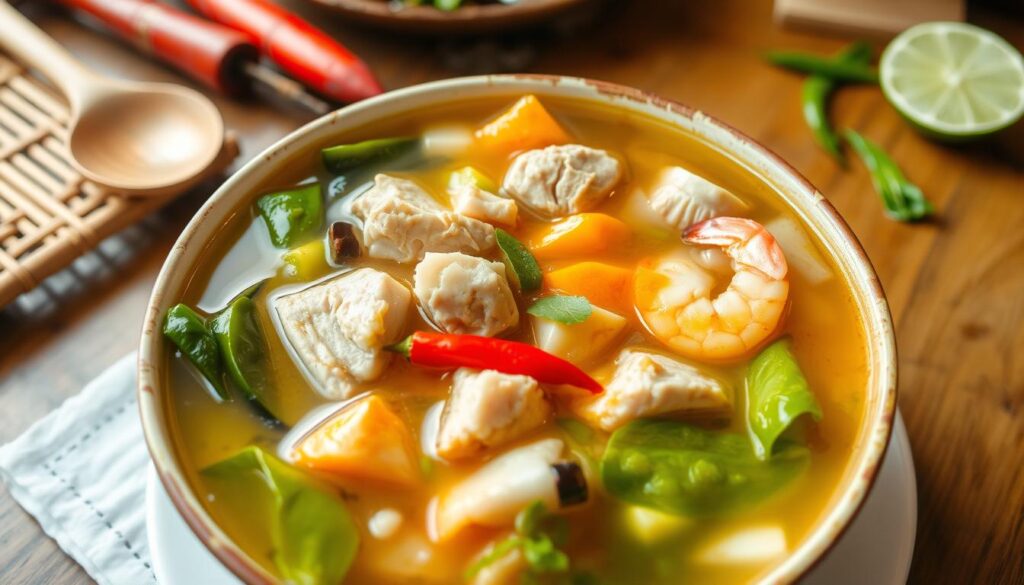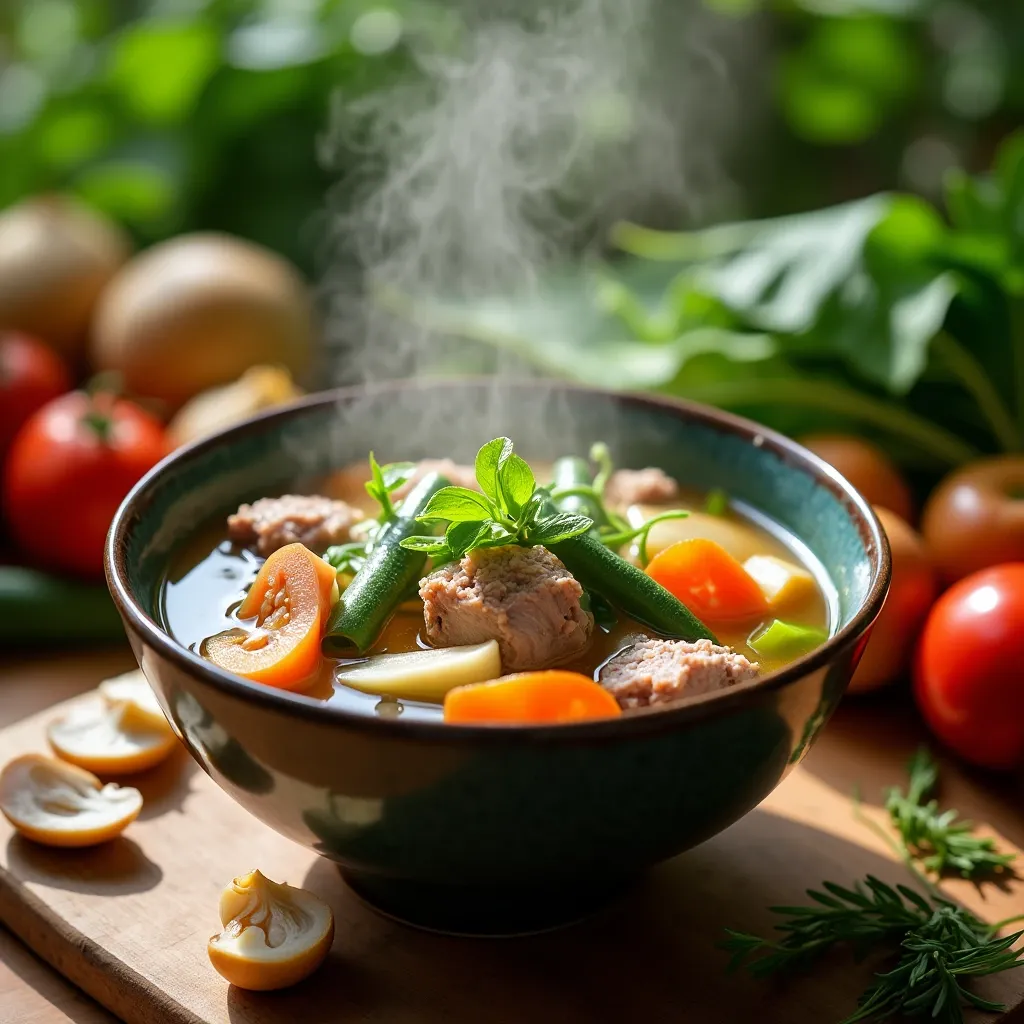Sinigang is a favorite Filipino soup loved by many. It’s known for its tangy taste, made with meats and veggies. It’s a big part of the Philippines’ food culture. But, is it really good for you? Let’s dive into the health benefits and nutrition facts of this beloved dish.

Key Takeaways
- Sinigang is a traditional Filipino soup dish known for its tangy and savory flavor profile.
- The dish is made with a variety of meats, vegetables, and a souring agent, often tamarind or calamansi.
- Sinigang can be a nutritious meal option, providing a balance of protein, vitamins, and minerals.
- The sour broth of sinigang may offer health benefits, such as aiding digestion and providing antioxidants.
- Moderation is key, as sinigang can be high in sodium, which may be a concern for those with certain dietary restrictions.
Understanding Filipino Sinigang: A Traditional Soup Dish
Sinigang is a sour soup loved in Filipino cuisine. It has been a favorite for generations. The tangy taste comes from souring agents. Knowing its origins and cultural value helps us understand Filipino food traditions.
Origins and Cultural Significance
Sinigang’s roots go back to before the Spanish came. It mixed the cooking ways of indigenous groups and Spanish influences. Today, it’s a key part of Filipino culture, bringing families and communities together.
Common Ingredients Used in Sinigang
- Meat (such as pork, beef, or fish)
- Souring agents (e.g., tamarind, kamias, calamansi, or tomatoes)
- Vegetables (such as long beans, okra, water spinach, or taro leaves)
- Aromatics (such as onions, garlic, and ginger)
- Fish sauce or salt for seasoning
Traditional Preparation Methods
Making sinigang is a detailed process. It starts with simmering meat in a broth. Souring agents are added early to mix flavors. Then, vegetables are added one by one, balancing textures and tastes.

Every region in the Philippines has its own sinigang twist. This shows how Filipino food is rich and diverse. Sinigang keeps winning hearts, both locally and worldwide.
Is Filipino Sinigang Healthy? A Comprehensive Analysis
Philippine sinigang is packed with health benefits. It’s a traditional sour soup loved by many. It also boosts your diet with its nutritional value.
The soup’s ingredients, like meats, veggies, and sour broth, are key. They give you protein and essential vitamins and minerals. The sour taste, from tamarind or citrus, adds a special touch to its health perks.
| Nutrient | Quantity (per serving) |
|---|---|
| Calories | 200 kcal |
| Protein | 20 g |
| Carbohydrates | 15 g |
| Fat | 8 g |
| Vitamin C | 30 mg |
| Potassium | 450 mg |
Adding sinigang to your meals can boost your health. Its rich flavor and nutrients make it a great choice for a healthy diet.
“Sinigang is not only a delicious Filipino staple but also a nutritious option that can support a balanced diet.”
In conclusion, sinigang is a healthy choice for your meals. Knowing its nutritional benefits helps you include it in your diet. This flavorful dish can be a great addition to a healthy lifestyle.
Nutritional Breakdown of Sinigang Components
Sinigang is a favorite Filipino soup that’s more than just tasty. It’s packed with nutrients. Let’s look at what makes it so good for you.
Protein Content from Meat Options
Sinigang has different meats like pork, beef, or seafood. These add a lot of protein to the dish. For example, a 3.5-ounce serving of pork has about 26 grams of protein.
Vegetable Nutrition Profile
- It’s full of veggies like tomatoes, onions, and greens. These are rich in vitamins, minerals, and antioxidants.
- One serving of sinigang can give you a lot of vitamin C and A. It also has other nutrients, depending on the ingredients.
Caloric Content and Serving Size
| Ingredient | Serving Size | Calories |
|---|---|---|
| Pork | 3.5 oz (100g) | 242 kcal |
| Tomato | 1 medium (123g) | 22 kcal |
| Spinach | 1 cup (30g) | 7 kcal |
| Onion | 1/2 cup (60g) | 30 kcal |
The calories in sinigang depend on the ingredients and how much you eat. But it’s mostly low in calories. This makes it good for those watching their weight.
Health Benefits of Sinigang’s Sour Broth
The sour broth of Sinigang is more than tasty. It’s packed with health benefits. Tamarind, the key ingredient, is known for its health perks.
Tamarind is full of antioxidants. These help fight off harmful free radicals and stress. They also support improved digestive health by boosting good gut bacteria.
The broth also has anti-inflammatory compounds. These can help reduce body inflammation. This is good for people with arthritis or gout.
Moreover, the broth boosts the immune system. Tamarind is rich in vitamin C and other nutrients. These help the body fight off infections and illnesses.
Adding Sinigang’s sour broth to your meals is healthy and tasty. It can improve digestion, reduce inflammation, and strengthen your immune system. Try it out for better health.
Vitamin and Mineral Content in Sinigang
Sinigang, the beloved Filipino sour soup, is more than just a tasty dish. It’s also packed with vitamins and minerals that are good for your health.
Essential Vitamins Present
The ingredients in sinigang, like tomatoes and leafy greens, are full of vitamins. They have vitamin C for a strong immune system and healthy skin. They also have vitamin A for good vision and cell growth. Plus, they contain B vitamins like thiamin, riboflavin, and niacin, which help with energy and nerve function.
Key Minerals and Their Benefits
- Calcium: Supports strong bones and teeth.
- Iron: Helps transport oxygen throughout the body and prevents anemia.
- Potassium: Regulates blood pressure and maintains fluid balance.
- Magnesium: Assists in muscle and nerve function, as well as energy production.
Antioxidant Properties
The sour broth of sinigang is not just tasty; it’s also full of antioxidants. The tart citrus flavors from tamarind or calamansi have compounds that fight off harmful free radicals. This helps protect cells and adds to the dish’s health benefits.
Adding sinigang to your meals means you get a flavorful dish that’s also good for you. It’s a great way to boost your vitamin, mineral, and antioxidant intake.
Low-Calorie Properties and Weight Management
Philippine sinigang is known for being low in calories, perfect for those watching their weight. This traditional low-calorie soup is full of flavor and nutrients. It helps support healthy weight goals.
sinigang is a healthy Filipino recipe for losing weight because it’s low in calories. A serving has about 200-300 calories, depending on the ingredients. This lets people add sinigang to their diet without worrying about calories.
The sour broth in sinigang may boost metabolism and digestion. The acidity could help the body’s natural processes, aiding in weight control. Plus, the many vegetables in sinigang add fiber. This makes you feel full and supports digestive health.
If you want to lose weight or keep a healthy weight, try sinigang. Its low-calorie nature and potential benefits for metabolism make it a great choice. It’s a healthy option for managing weight.
Potential Health Concerns and Considerations
Philippine sinigang is a tasty and healthy soup. However, there are some health issues to think about. The sour broth can have a lot of sodium from tamarind or other souring agents.
Sodium Content Awareness
Sinigang can have a lot of sodium. This is especially true if it’s made with commercial seasoning mixes or broths. People on low-sodium diets or with high blood pressure should be careful.
Modifications for Dietary Restrictions
- To lower sodium, use low-sodium broth or stock. Also, reduce salt and limit salty ingredients like fish sauce or shrimp paste.
- People with food allergies or intolerances might need to change the dish. This could mean using different proteins or avoiding certain veggies.
- Vegetarians and vegans can enjoy sinigang by skipping the meat. Use tofu, mushrooms, or other meat substitutes instead.
By being aware of these health concerns and making the right changes, sinigang can be a great addition to a healthy diet. It’s good for everyone, even those with special dietary needs.
Making Sinigang Healthier: Tips and Modifications
Sinigang, the beloved Filipino sour soup, is already nutritious. But, you can make it even healthier. By adding a few simple tips and changes, you can enjoy this traditional favorite while boosting its health benefits.
Opt for Low-Sodium Options
One main concern with sinigang is its sodium content. This is especially true when using pre-made sour mix or concentrated broths. To lower sodium intake, use low-sodium broth or homemade tamarind base instead. This simple change can greatly reduce the dish’s salt content.
Maximize Vegetable Nutrition
Sinigang is a great way to add many nutritious vegetables to your diet. Try experimenting with different vegetable-rich variations, like adding more greens, root vegetables, or mushrooms. This not only makes the dish taste better but also increases its vitamin, mineral, and antioxidant profile.
Control Portion Sizes
Even though sinigang is low in calories, it’s key to watch portion sizes. Choose smaller servings and pair it with lean protein and whole grains for a balanced, nutrient-dense meal. This helps keep calorie intake healthy and supports weight management.
By using these tips and changes, you can enjoy the flavorful and comforting sinigang while making it healthier. Whether you want to cut down on sodium, add more veggies, or control portions, these strategies can make this traditional dish more nutritious and satisfying.
Comparing Sinigang to Other Asian Soups
Philippine sinigang is a favorite and healthy soup. It’s different from other Asian soups because of its sour taste and health perks. Miso soup from Japan is known for its fermented broth and veggies. Thai Tom Yum Goong has a spicy-sour broth with shrimp, lemongrass, and kaffir lime leaves.
Sinigang’s sourness comes from tamarind or other acidic ingredients. This sourness makes the dish refreshing and adds health benefits. It may help with digestion and weight management, making it a great choice among Asian soups.
Each Asian soup has its own culture and health benefits. But sinigang stands out with its mix of savory, sour, and nutritious elements. You can also add different proteins and veggies to make it even better, making it a healthy and tasty option in Asian cuisine.
FAQ
What is the nutritional value of Filipino sinigang?
Sinigang is a healthy dish. It’s full of vegetables and lean proteins. It’s low in calories and rich in vitamins and minerals. It’s good for weight management.
What are the common ingredients used in sinigang?
Sinigang has many vegetables like tomatoes, onions, taro, and leafy greens. It also has proteins like pork, beef, fish, or shrimp. The sour taste comes from tamarind or other souring agents.
How does the sour broth in sinigang contribute to its health benefits?
The sour broth, made with tamarind, aids digestion. It also boosts the immune system. This is because of its vitamin C and antioxidants.
Is sinigang suitable for those on a low-sodium diet?
Sinigang can be high in sodium because of fish sauce or salt. But, you can make it lower in sodium. Use less salt or try different seasonings.
Can sinigang be modified for specific dietary needs?
Yes, sinigang can be changed for different diets. You can use different proteins, add more veggies, or adjust the sourness.
How does sinigang compare to other Asian soup dishes in terms of health benefits?
Sinigang is unique because of its veggies, lean proteins, and sour broth. It’s healthier than many Asian soups. It’s also culturally important.

